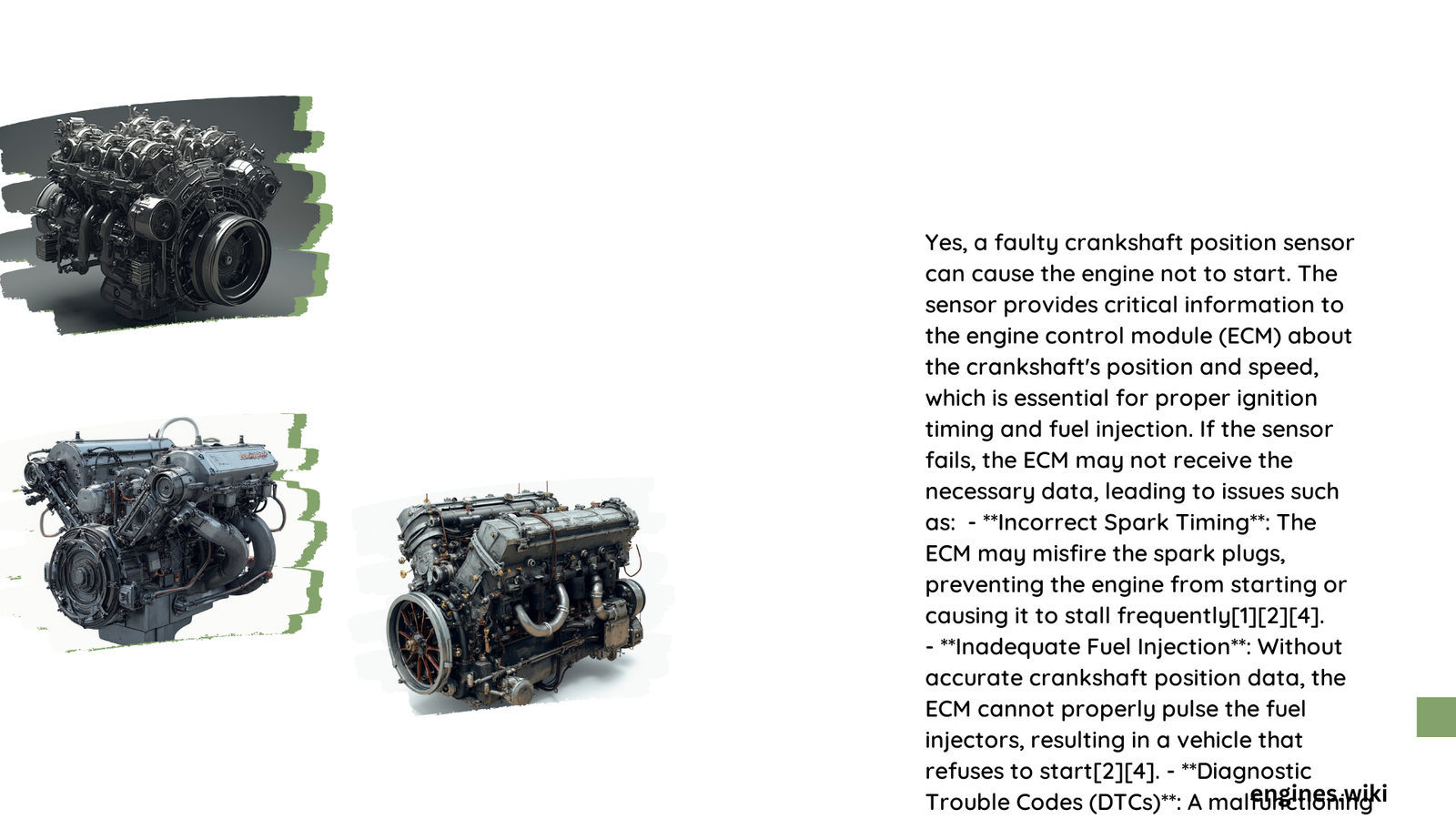A faulty crankshaft position sensor can indeed prevent an engine from starting. This critical component provides essential information to the engine control unit (ECU) about the crankshaft’s position and rotational speed. When it malfunctions, the ECU cannot determine the correct timing for fuel injection and ignition, leading to starting issues. This article explores the relationship between crankshaft sensors and engine starting problems, providing insights into diagnosis, symptoms, and repair.
What Are the Symptoms of a Failing Crankshaft Sensor?
A malfunctioning crankshaft position sensor can manifest in several ways:
- Engine Won’t Start: The most common and severe symptom is the engine’s inability to start.
- Check Engine Light: Illumination of the check engine light on the dashboard.
- Engine Misfires: Irregular engine performance or misfires during operation.
- Stalling: The engine may stall unexpectedly while idling or driving.
- Poor Fuel Economy: Decreased fuel efficiency due to improper fuel injection timing.
How Does a Crankshaft Sensor Affect Engine Starting?

The crankshaft sensor plays a crucial role in the engine starting process:
- Timing Signals: It provides timing signals to the ECU for precise fuel injection and ignition timing.
- RPM Information: The sensor relays real-time RPM data to the ECU.
- Synchronization: It helps synchronize the engine’s moving parts for optimal performance.
When the sensor fails, the ECU lacks the necessary information to initiate and maintain proper engine operation, often resulting in starting failure.
What Are the Common Diagnostic Trouble Codes for Crankshaft Sensor Issues?
Diagnostic trouble codes (DTCs) related to crankshaft sensor problems include:
| DTC Code | Description |
|---|---|
| P0335 | Crankshaft Position Sensor A Circuit Malfunction |
| P0336 | Crankshaft Position Sensor A Circuit Range/Performance |
| P0337 | Crankshaft Position Sensor A Circuit Low Input |
| P0338 | Crankshaft Position Sensor A Circuit High Input |
These codes can be retrieved using an OBD-II scanner and provide valuable information for diagnosis.
How to Diagnose a Faulty Crankshaft Sensor?
Follow these steps to diagnose a potential crankshaft sensor issue:
- Check for DTCs: Use an OBD-II scanner to retrieve any stored trouble codes.
- Visual Inspection: Examine the sensor and its wiring for visible damage or corrosion.
- Resistance Test: Use a multimeter to measure the sensor’s resistance, comparing it to manufacturer specifications.
- Voltage Output Test: Check the sensor’s voltage output while cranking the engine.
- Oscilloscope Analysis: For advanced diagnosis, use an oscilloscope to analyze the sensor’s waveform.
What Are the Repair Options for a Faulty Crankshaft Sensor?
When dealing with a faulty crankshaft sensor, consider these repair options:
- Cleaning: In some cases, cleaning the sensor and its connections may resolve the issue.
- Replacement: If the sensor is damaged or worn, replacement is often the best solution.
- Wiring Repair: Address any damaged wiring or connectors associated with the sensor.
- ECU Update: In rare cases, an ECU software update may be necessary to resolve sensor-related issues.
What Is the Cost and Time Frame for Crankshaft Sensor Replacement?
The cost and time for crankshaft sensor replacement can vary:
- Cost Range: Typically between $50 to $250, depending on the vehicle make and model.
- Labor Time: Usually 1 to 2 hours for most vehicles.
- DIY Difficulty: Moderate, depending on sensor location and accessibility.
Can You Drive with a Bad Crankshaft Sensor?
Driving with a faulty crankshaft sensor is not recommended:
- Safety Risk: The engine may stall unexpectedly, creating dangerous driving conditions.
- Further Damage: Continued operation may lead to additional engine damage.
- Poor Performance: The vehicle will likely experience reduced performance and fuel efficiency.
How to Prevent Crankshaft Sensor Failure?
To minimize the risk of crankshaft sensor failure:
- Regular Maintenance: Follow the manufacturer’s recommended maintenance schedule.
- Keep Engine Clean: Prevent oil and debris buildup around the sensor.
- Address Check Engine Lights: Promptly investigate any warning lights or unusual engine behavior.
- Quality Parts: Use high-quality replacement parts when servicing the vehicle.
In conclusion, a faulty crankshaft sensor can indeed cause an engine not to start. Understanding the symptoms, diagnostic procedures, and repair options can help vehicle owners address this issue promptly and effectively, ensuring optimal engine performance and reliability.
References:
1. How to Start a Car with a Bad Crankshaft Sensor – Nevsemi Blog
2. Symptoms of a Bad Crankshaft Position Sensor – AutoZone
3. Failure to Start: Diagnosing Cam / Crank Sensor vs Starter vs Battery – The New X Forum
